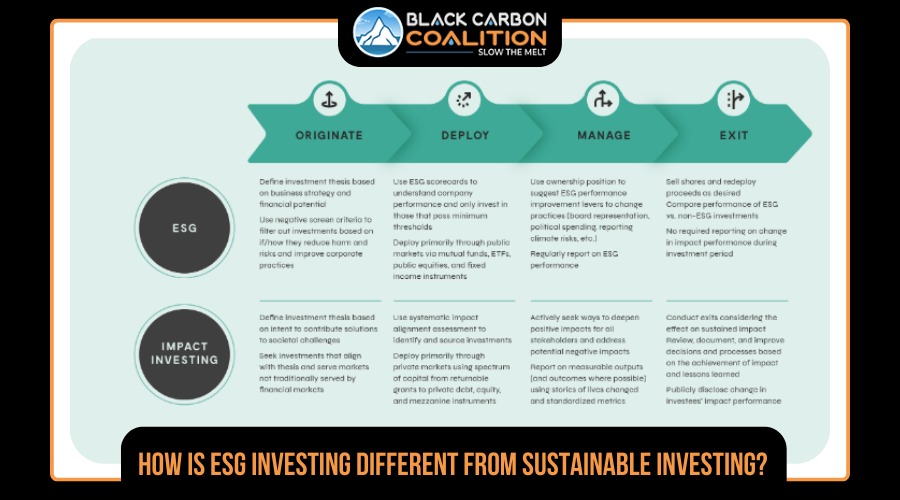The key difference between ESG investing and sustainable investing is that ESG investing focuses specifically on environmental, social, and governance criteria while sustainable investing also considers a broad range of sustainability factors.
ESG investing aims to generate positive environmental and social impact as well as financial returns. Sustainable investing, on the other hand, takes a more holistic approach to investing, considering a range of environmental, social, and governance factors.
Both ESG and sustainable investors seek to avoid investments that could be negatively impacted by environmental or social issues. However, sustainable investors may also choose to invest in companies that are working to mitigate environmental or social problems.
There is a growing body of evidence showing that ESG and sustainable investing can offer financial benefits. For example, a recent study found that companies with strong ESG ratings outperformed those with weak ratings by 3% per year over the past decade.
While there is some overlap between ESG and sustainable investing, the two approaches are not identical. Investors should consider their own goals and preferences when deciding which approach is right for them.
Benefits of ESG investing:
1) It can help you avoid investments that could be negatively impacted by environmental or social problems.
2) It can offer financial benefits, such as outperformance of companies with weak ESG ratings.
3) It can generate positive environmental and social impact.
Drawbacks of ESG investing:
1) It may require additional research to find companies that meet your criteria.
2) You may have to sacrifice some financial return in order to achieve your environmental and social goals.
3) Your investment choices may be limited if you invest only in companies that meet your ESG criteria.
Benefits of sustainable investing:
1) It takes a more holistic approach to invest, considering a range of environmental, social, and governance factors.
2) It can help you find investments that are working to mitigate environmental or social problems.
3) It offers the potential for financial benefits, such as the outperformance of companies with weak sustainability ratings.
Drawbacks of sustainable investing:
1) It may require additional research to find companies that meet your criteria.
2) You may have to sacrifice some financial return in order to achieve your sustainability goals.
3) Your investment choices may be limited if you invest only in companies that meet your sustainability criteria.
What are the major characteristics of ESG Investing?
The three key characteristics of ESG investing are environmental, social, and governance criteria.
1) Environmental: This refers to a company’s impact on the environment. For example, a company that produces renewable energy would have a positive environmental impact while a company that pollutes the air would have a negative environmental impact.
2) Social: This refers to a company’s impact on society. For example, a company that provides safe working conditions and living wages would have a positive social impact while a company that uses child labor would have a negative social impact.
3) Governance: This refers to a company’s governance practices. For example, a company with strong corporate governance practices would be more likely to have positive ESG ratings than a company with weak governance practices.
ESG investing is a type of sustainable investing that focuses specifically on environmental, social, and governance criteria. Sustainable investing is a more holistic approach that considers a broad range of sustainability factors. Both ESG and sustainable investing can offer financial benefits, but they may also require sacrifices in terms of return. Investors should consider their own goals and preferences when deciding which approach is right for them.
Characteristics of sustainable investing?
Sustainable investing is a more holistic approach that considers a broad range of sustainability factors. This includes environmental, social, and governance criteria, as well as other factors such as a company’s carbon footprint or water usage. Sustainable investing can offer financial benefits, but it may also require sacrifices in terms of return. Investors should consider their own goals and preferences when deciding which approach is right for them.
What are the right ways to step into ESG investing?
The right way to step into ESG investing will vary depending on your goals and preferences. If you want to focus specifically on environmental, social, and governance criteria, you can look for exchange-traded funds (ETFs) or mutual funds that track those factors. If you want a more holistic approach, you can consider sustainable ETFs or mutual funds. You can also invest in individual stocks or bonds of companies that meet your ESG criteria.
What are some things to consider before investing in ESG?
Before investing in ESG, you should consider your financial goals and risk tolerance. You should also research the specific ETFs or mutual funds you are considering investing in to make sure they align with your goals. Additionally, you should be aware that sustainable investing may sacrifice some financial return in order to achieve sustainability goals.
What are the right ways to step into sustainable investing?
The right way to step into sustainable investing will vary depending on your goals and preferences. If you want a more holistic approach, you can consider sustainable ETFs or mutual funds. You can also invest in individual stocks or bonds of companies that meet your sustainability criteria.
What are some things to consider before investing in sustainability?
Before investing in sustainability, you should consider your financial goals and risk tolerance. You should also research the specific ETFs or mutual funds you are considering investing in to make sure they align with your goals. Additionally, you should be aware that sustainable investing may sacrifice some financial return in order to achieve sustainability goals.
Conclusion
ESG investing is a type of sustainable investing that focuses specifically on environmental, social, and governance criteria. Sustainable investing is a more holistic approach that considers a broad range of sustainability factors. Both ESG and sustainable investing can offer financial benefits, but they may also require sacrifices in terms of return. Investors should consider their own goals and preferences when deciding which approach is right for them.

